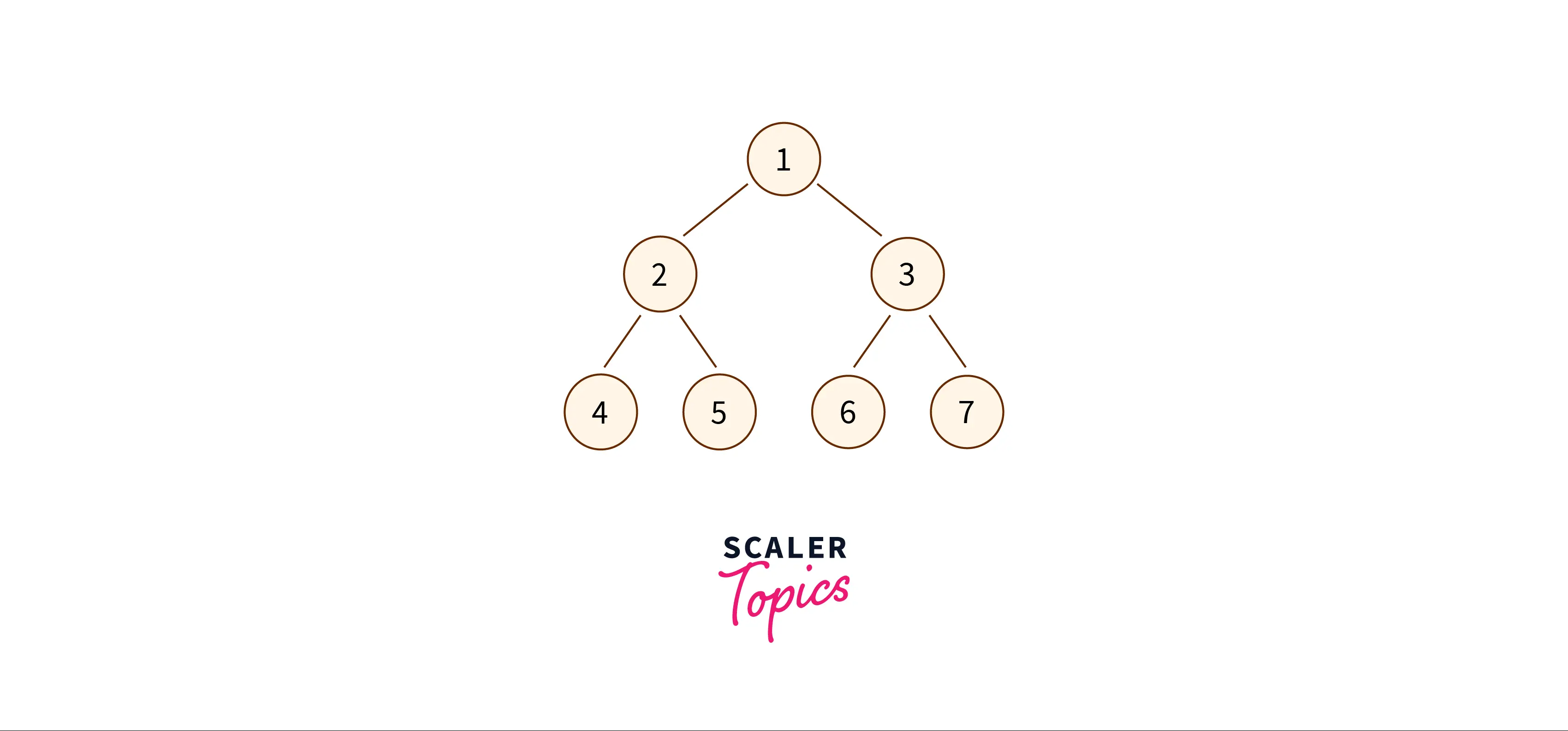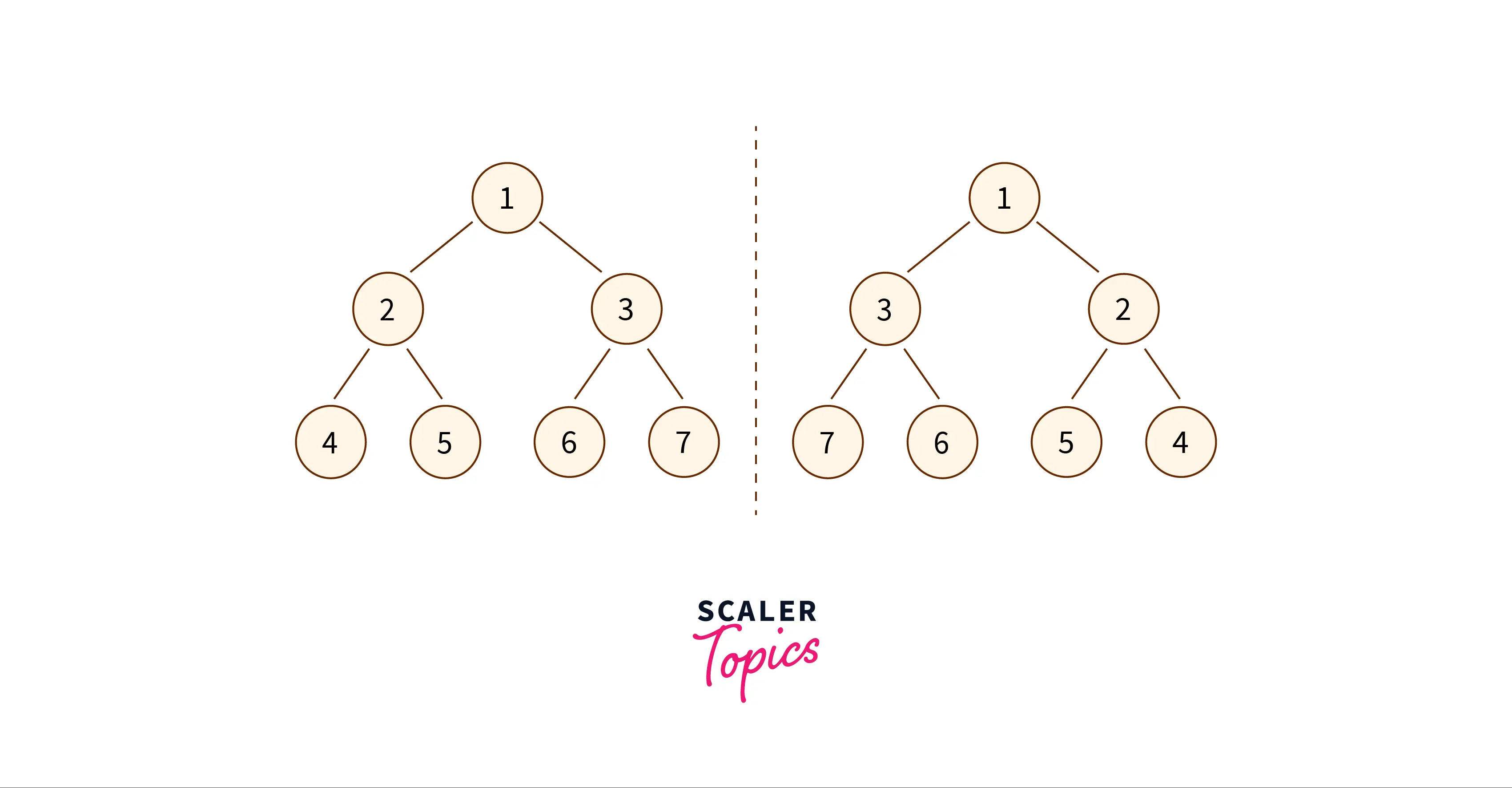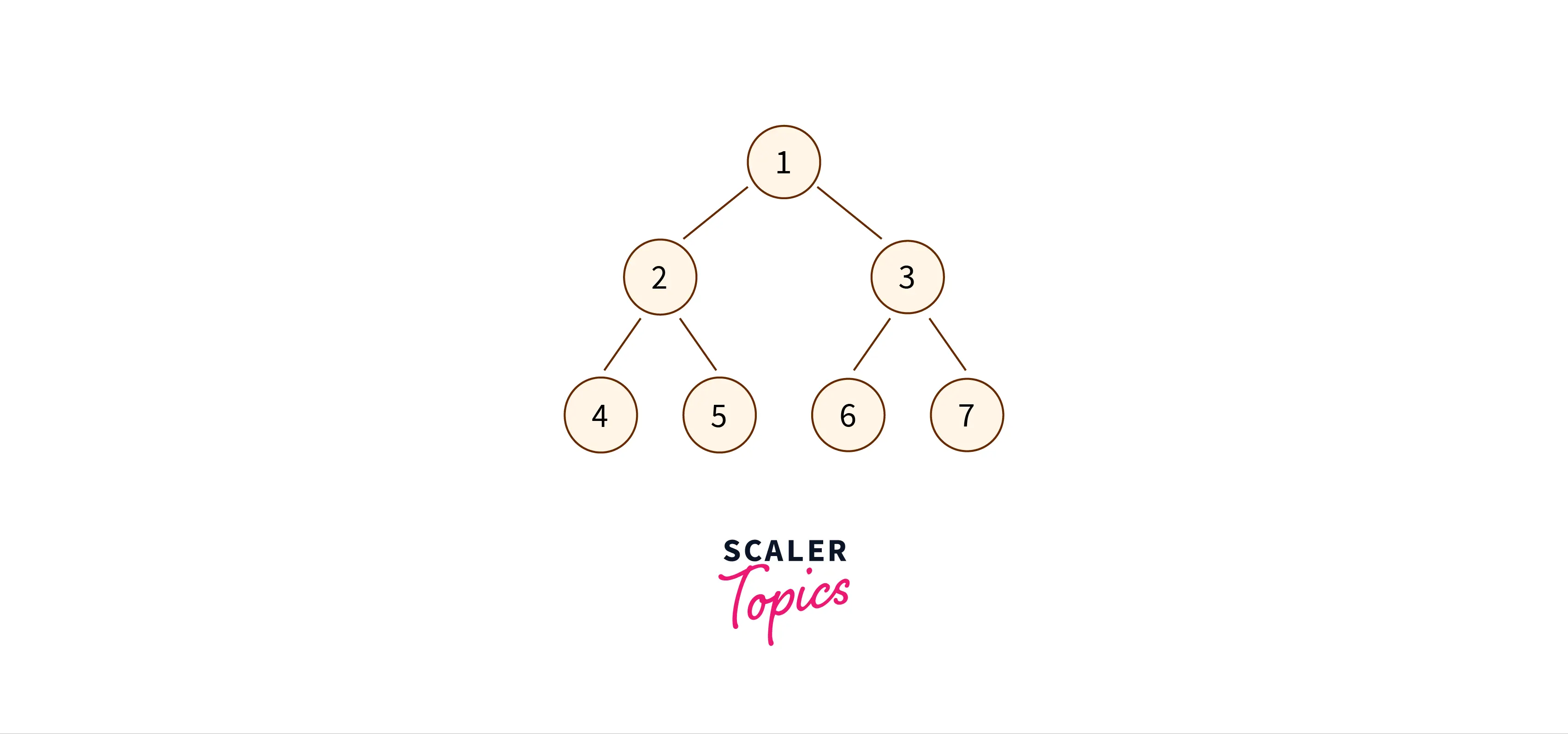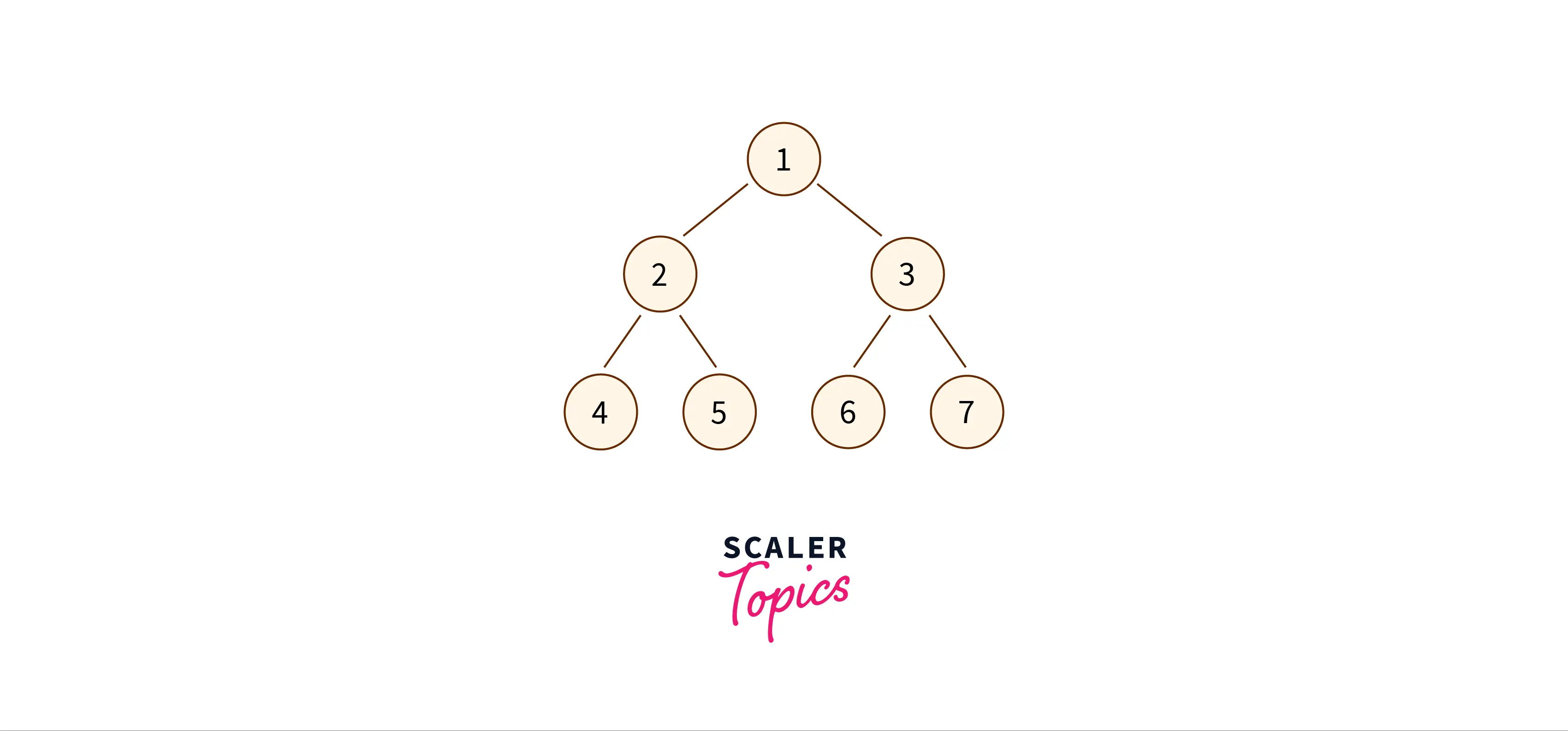Problem Statement
Given a binary tree, our task is to convert this binary tree into its mirror tree. A mirror tree is another form of a binary tree where the left and right children of all non-leaf nodes are interchanged.
Example of Mirror Tree
Let us try to mirror the following binary tree:

Example Explanation

In the above-shown example consider the dotted line as a mirror thus the tree on the left side is the original binary tree while tree on the right is the mirrored binary tree.
Input/ Output of Mirror Tree
The input statement contains each tree node’s data separated by a single space in a single line. If any node in the binary tree is NULL, we will put -1 in its place. Therefore, for the tree depicted in the above example the input will be given as:
1 2 3 4 5 6 7 -1 -1 -1 -1 -1 -1 -1 -1
The output for the above given input will the following:
Inorder traversal of original tree is
4 2 5 1 6 3 7
Inorder traversal of the mirrored tree is
7 3 6 1 5 2 4 Here, output includes the Inorder traversal for both the original and mirrored tree.
Constraints of Mirror tree
Here N is the number of nodes in the tree, and Data denotes the value contained in the node of the binary tree.
Approach 1- Recursive
The intuition of this approach is to solve the problem using recursion. We will create a mirror() function that will recursively mirror the left and right sub-tree.
- Algorithm The algorithm for this approach is as follows:
- Call the mirror function for the left sub-tree, i.e.
Mirror(left sub-tree)Call the mirror function for the right sub-tree, i.e.Mirror(right sub-tree)Swap left and right sub-trees using,- temp = left sub-treeleft sub-tree = right sub-treeright sub-tree = temp
- Call the mirror function for the left sub-tree, i.e.
Implementation
Let us now see the implementation of the Mirror for the following binary tree in C++:

#include<bits/stdc++.h>
using namespace std;
/* a binary tree node has data, pointer
to left child and a pointer to right child */
struct Node {
int data;
struct Node* left;
struct Node* right;
};
/* function that allocates a new node with
the given data and NULL left and right pointers */
struct Node* newNode(int data) {
struct Node* node = (struct Node*)
malloc(sizeof(struct Node));
node->data = data;
node->left = NULL;
node->right = NULL;
return(node);
}
void mirror(struct Node* node) {
if (node == NULL)
return;
else {
struct Node* temp;
// mirror the subtrees
mirror(node->left);
mirror(node->right);
// swapping the pointers for this node
temp = node->left;
node->left = node->right;
node->right = temp;
}
}
// function to print Inorder traversal
void inorder(struct Node* node) {
if (node == NULL)
return;
inorder(node->left);
cout << node->data << " ";
inorder(node->right);
}
int main() {
struct Node *root = newNode(1);
root->left = newNode(2);
root->right = newNode(3);
root->left->left = newNode(4);
root->left->right = newNode(5);
root->right->left = newNode(6);
root->right->right = newNode(7);
// inorder traversal of the original tree
cout << "Inorder traversal of original tree is" << endl;
inorder(root);
// mirror the tree
mirror(root);
// inorder traversal of the mirrored tree
cout << "\nInorder traversal of the mirrored tree is \n";
inorder(root);
return 0;
}
Output
Inorder traversal of original tree is
4 2 5 1 6 3 7
Inorder traversal of the mirrored tree is
7 3 6 1 5 2 4
Let us now see the implementation of the Mirror binary tree in Java:
import java.util.*;
class Main {
// a binary tree node has data, pointer to
// left child and a pointer to right child
static class Node {
int data;
Node left;
Node right;
}
// function that allocates
// a new node with the given data and null left and right pointers
static Node newNode(int data) {
Node newNode = new Node();
newNode.data = data;
newNode.left = null;
newNode.right = null;
return newNode;
}
// function to print Inorder traversal
static void inorder(Node root) {
if (root == null)
return;
inorder(root.left);
System.out.print(root.data + " ");
inorder(root.right);
}
static Node mirror(Node root) {
if (root == null) {
return null;
}
// mirror the subtrees
Node mirror = newNode(root.data);
mirror.right = mirror(root.left);
mirror.left = mirror(root.right);
return mirror;
}
public static void main(String args[]) {
Node root = newNode(1);
root.left = newNode(2);
root.right = newNode(3);
root.left.left = newNode(4);
root.left.right = newNode(5);
root.right.left = newNode(6);
root.right.right = newNode(7);
// inorder traversal of the input tree
System.out.print("Inorder traversal of original tree is \n");
inorder(root);
Node mirror = null;
mirror = mirror(root);
// inorder traversal of the mirrored tree
System.out.print("\nInorder traversal of the mirrored tree is \n");
inorder(mirror);
}
}
Output
Inorder traversal of original tree is
4 2 5 1 6 3 7
Inorder traversal of the mirrored tree is
7 3 6 1 5 2 4
Let us now see the implementation of the Mirror binary tree in Python
# function to create a new tree node
class newNode:
def __init__(self,data):
self.data = data
self.left = self.right = None
def mirror(node):
if (node == None):
return
else:
temp = node
# mirror the subtrees
mirror(node.left)
mirror(node.right)
# swapping the pointers for this node
temp = node.left
node.left = node.right
node.right = temp
# function to print Inorder traversal
def inorder(node) :
if (node == None):
return
inorder(node.left)
print(node.data, end = " ")
inorder(node.right)
root = newNode(1)
root.left = newNode(2)
root.right = newNode(3)
root.left.left = newNode(4)
root.left.right = newNode(5)
root.right.left = newNode(6)
root.right.right = newNode(7)
# inorder traversal of the original tree
print("Inorder traversal of original tree is")
inorder(root)
# mirror the tree
mirror(root)
# inorder traversal of the mirrored tree
print("\nInorder traversal of the mirrored tree is")
inorder(root)
Output
Inorder traversal of original tree is
4 2 5 1 6 3 7
Inorder traversal of the mirrored tree is
7 3 6 1 5 2 4
Time Complexity
- In the above code implementation, we are using the recursive approach along with updating the pointers at every recursive call (that are constant time operations thus having a time complexity of
Space Complexity
If we consider the size of the stack for function calls, the space complexity of the above implemented recursive approach is
Approach 2- Iterative method using Queues
- The intuition of this approach is to implement level order traversal using the queue data structure. While doing traversal, swap left and right children of every node.
- Algorithm The algorithm for this approach is as follows:
- Perform a level order traversal, swapping every left and right child
- Create a queue and add the root node to it.
- If the queue is not empty,
- deque node from the queue
- swap left and right children of the removed node
- push back the left and right child of the removed node to the queue
- return to step 3
Implementation
Let us now see the implementation of the Mirror for the following binary tree in C++:
- Let us now see the implementation of the Mirror for the following binary tree in C++:

#include<bits/stdc++.h>
using namespace std;
/* a binary tree node has data, pointer to
left child and a pointer to right child */
struct Node {
int data;
struct Node* left;
struct Node* right;
};
/* function that allocates a new node
with the given data and NULL left and right pointers */
struct Node* newNode(int data) {
struct Node* node = new Node;
node->data = data;
node->left = node->right = NULL;
return(node);
}
void mirror(Node* root) {
if (root == NULL)
return;
queue<Node*> q;
q.push(root);
// while implementing level order traversal, keep swapping
// left and right children
while (!q.empty()) {
// pop top node from queue
Node* curr = q.front();
q.pop();
// swap left child with right child
swap(curr->left, curr->right);
// push left and right children
if (curr->left)
q.push(curr->left);
if (curr->right)
q.push(curr->right);
}
}
// function to print Inorder traversal
void inorder(struct Node* node) {
if (node == NULL)
return;
inorder(node->left);
cout << node->data << " ";
inorder(node->right);
}
int main() {
struct Node *root = newNode(1);
root->left = newNode(2);
root->right = newNode(3);
root->left->left = newNode(4);
root->left->right = newNode(5);
root->right->left = newNode(6);
root->right->right = newNode(7);
// inorder traversal of the original tree
cout << "Inorder traversal of original tree is" << endl;
inorder(root);
// mirror the tree
mirror(root);
// inorder traversal of the mirrored tree
cout << "\nInorder traversal of the mirrored tree is \n";
inorder(root);
return 0;
}
Output
Inorder traversal of original tree is
4 2 5 1 6 3 7
Inorder traversal of the mirrored tree is
7 3 6 1 5 2 4
Let us now see the implementation of the Mirror binary tree in Java:
import java.util.*;
class Main {
/* a binary tree node has data, pointer to
left child and a pointer to right child */
static class Node {
int data;
Node left;
Node right;
};
/* function that allocates a new node
with the given data and null left and right pointers */
static Node newNode(int data) {
Node node = new Node();
node.data = data;
node.left = node.right = null;
return(node);
}
static void mirror(Node root)
{
if (root == null)
return;
Queue<Node> q = new LinkedList<>();
q.add(root);
// while implementing level order traversal, keep swapping
// left and right children
while (q.size() > 0) {
// pop top node from queue
Node curr = q.peek();
q.remove();
// swap left child with right child
Node temp = curr.left;
curr.left = curr.right;
curr.right = temp;
// push left and right children
if (curr.left != null)
q.add(curr.left);
if (curr.right != null)
q.add(curr.right);
}
}
// function to print Inorder traversal
static void inorder( Node node)
{
if (node == null)
return;
inorder(node.left);
System.out.print( node.data + " ");
inorder(node.right);
}
public static void main(String args[]) {
Node root = newNode(1);
root.left = newNode(2);
root.right = newNode(3);
root.left.left = newNode(4);
root.left.right = newNode(5);
root.right.left = newNode(6);
root.right.right = newNode(7);
// inorder traversal of the original tree
System.out.print("Inorder traversal of original tree is \n");
inorder(root);
// mirror the tree
mirror(root);
// inorder traversal of the mirrored tree
System.out.print("\nInorder traversal of the mirrored tree is \n");
inorder(root);
}
}
Output
Inorder traversal of original tree is
4 2 5 1 6 3 7
Inorder traversal of the mirrored tree is
7 3 6 1 5 2 4
Let us now see the implementation of the Mirror binary tree in Python:
# function to create a new tree node
class newNode:
def __init__(self, data):
self.data = data
self.left = None
self.right = None
def mirror( root):
if (root == None):
return
q = []
q.append(root)
# while implmementing level order traversal, keep swapping
# left and right children
while (len(q)):
# pop top node from queue
curr = q[0]
q.pop(0)
# swap left child with right child
curr.left, curr.right = curr.right, curr.left
# append left and right children
if (curr.left):
q.append(curr.left)
if (curr.right):
q.append(curr.right)
# function to print Inorder traversal
def inorder( node):
if (node == None):
return
inorder(node.left)
print(node.data, end = " ")
inorder(node.right)
root = newNode(1)
root.left = newNode(2)
root.right = newNode(3)
root.left.left = newNode(4)
root.left.right = newNode(5)
root.right.left = newNode(6)
root.right.right = newNode(7)
# inorder traversal of the original tree
print("Inorder traversal of original tree is")
inorder(root)
# mirror the tree
mirror(root)
# inorder traversal of the mirrored tree
print("\nInorder traversal of the mirrored tree is")
inorder(root)
Output
Inorder traversal of original tree is
4 2 5 1 6 3 7
Inorder traversal of the mirrored tree is
7 3 6 1 5 2 4
Time Complexity
We implement level order traversal, which has a time complexity of
Space Complexity
Because this approach employs the queue data structure, the space complexity of this method is
Conclusion
- A mirror tree is a form of the binary tree where left and right children of all non-leaf nodes are interchanged.
- Complexities for Recursive approach
- Time Complexity –
- Space Complexity –
- Time Complexity –
- Complexities for Iterative approach using Queue data structure
- Time Complexity –
- Space Complexity –
- Time Complexity –